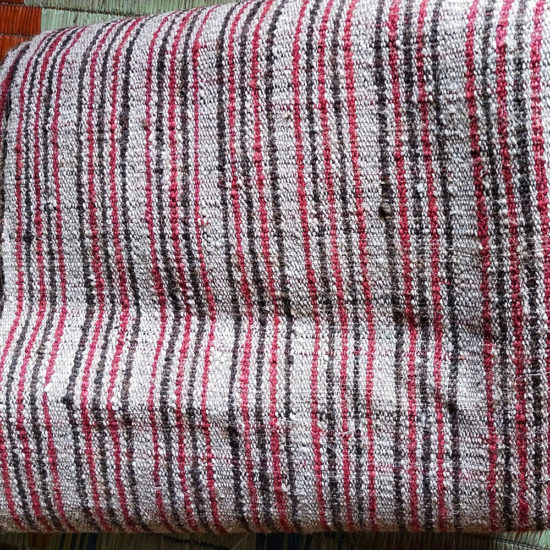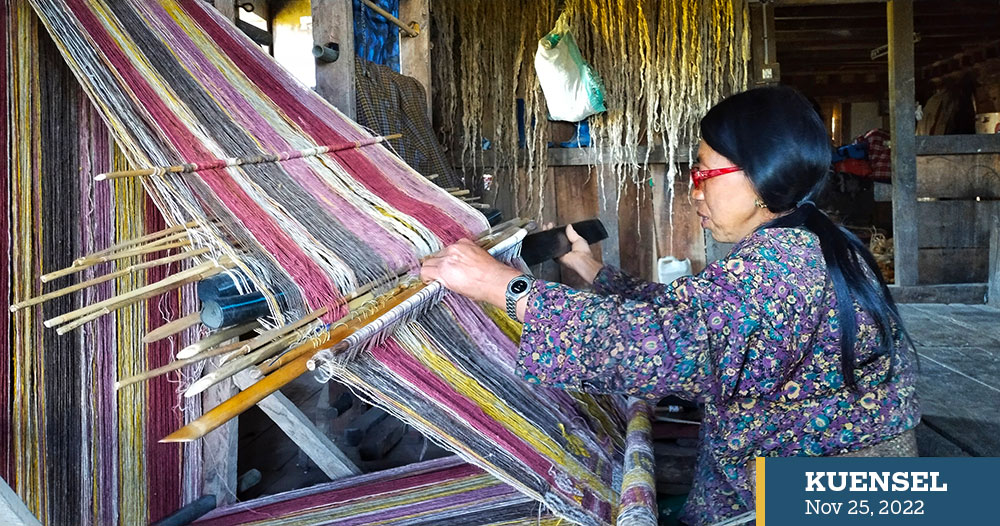A thorny bark is transformed into beautiful clothes during olden days
Neten Dorji | Lumang
Sonam Choden of Drupkhang in Lumang gewog is skilled at weaving fibres extracted from the bark of nettle plants (locally known as Zangru). She weaves everyday household items such as a bag, table cover, blanket, gho, and kira used in traditional Bhutanese homes.
The 52-year-old woman is worried about the future of her craft. She has passed on her skills to the younger generation of her community who are keen to keep it alive but their interest is severely challenged by the non-availability of raw materials.
Sonam Choden is just one of the few families in Drupkhang, who still produce traditional nettle items to sustain. The village located in the north of Lumang gewog is 30 minutes drive from the centre.
Because the work is labour-intensive, many have left it and moved to easier options threatening the existence of the once-thriving craft.


“I started weaving table covers, blankets and other items at the age of 20,” said Sonam Choden, who educated her two daughters in weaving nettles.
“Everyone has needed nettle fibres in the past to produce a blanket, which is used by almost everyone in every household,” she said.
She weaves two to three kiras and gho over the course of a year.
For centuries women in Drupkhang have extracted nettle fibres, spun them and wove mats, bags, sacks, and clothing. To make these various items, they developed lightweight spinners which could be used to spin the thread while resting in between household chores or walking.
“Every household should compulsorily have blankets. Apart from weaving blankets, they produced blankets and mats for guests to sit on and also to be used as bed covers,” said Choenzom, a 65-year-old native. “Sometimes, we even gave them as gifts to guests.”
She said that there are two types of gho and kira—plain and coloured. The locals don’t use any artificial colouring but the colour depends on the colour of the nettle.
Although women from the village prefer to produce their own gho and kira, they occasionally also sell them for Nu 50,000 and Nu 45,000 a piece respectively.
Choenzom, who has been weaving since her childhood, said that they have never woven items from zangru for sale.
“It is not easy to weave nettle cloths, as it is an arduous and long process,” she says.“And with the scarcity of nettles in recent years, we don’t get the value of our hardships anyway.”
The process of making clothes from zangru is laborious: after collecting zangru fibre, women soak it in water and then boil it in wood ash. It is then beaten and washed. Before hanging to dry, the fibres are coated with oil to prevent them from sticking together.
“It takes around two to three months to weave a gho or kira,” said Karma Choden. “If there are any machines to spin fibres, it would ease our work.”
Despite its importance, the practice of Zangru-weaving is waning rapidly.
“With the growing scarcity of nettles combined with easy availability of ready-made garments in the market, the trend is slowly dying,” said Dechen.
“If villagers could get enough nettles, and if new technology that would spin the fibres faster was introduced, then maybe the tradition could be saved,” she said.
Locals claimed that the ancestor’s occupation skills were at risk as nettle plants were also disappearing. However, they formed a group called Drupkhang Zangru group to keep culture alive.
The 13-member group has intervened and taken initiative to revive the nettle-weaving but it doesn’t make any difference.
“Lack of support, we are deviating from what we are skilled at doing. Our ancestor’s occupation skills are now at risk,” said an elderly woman.


